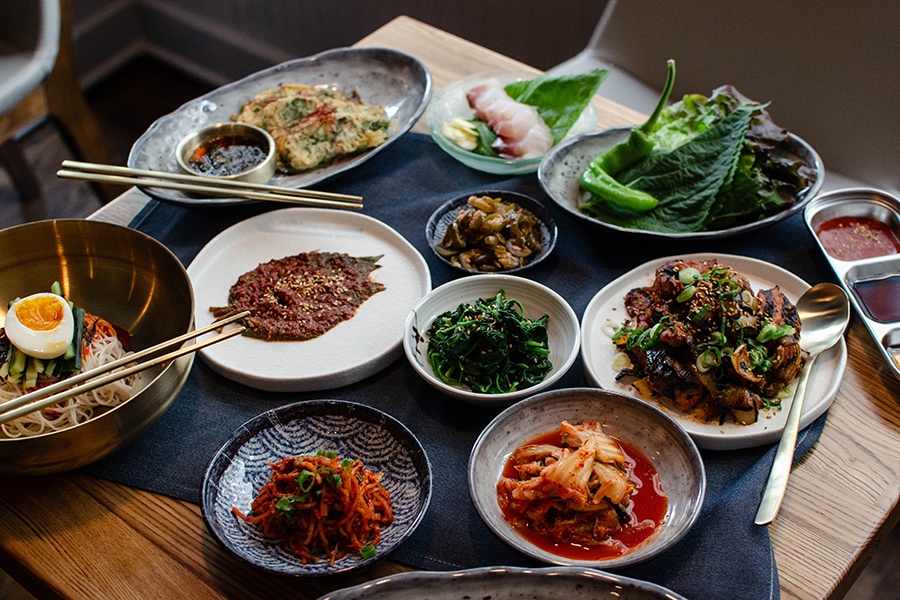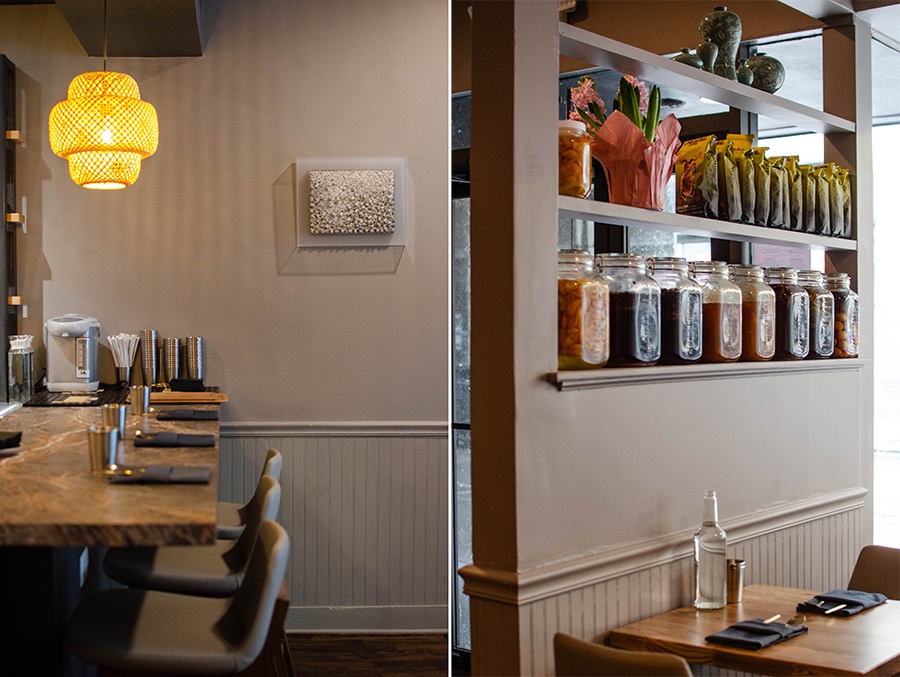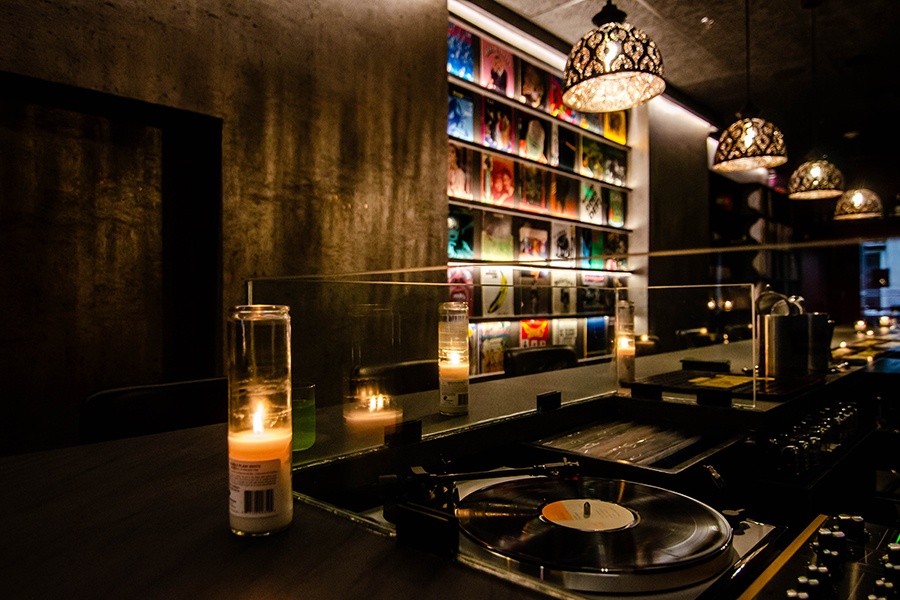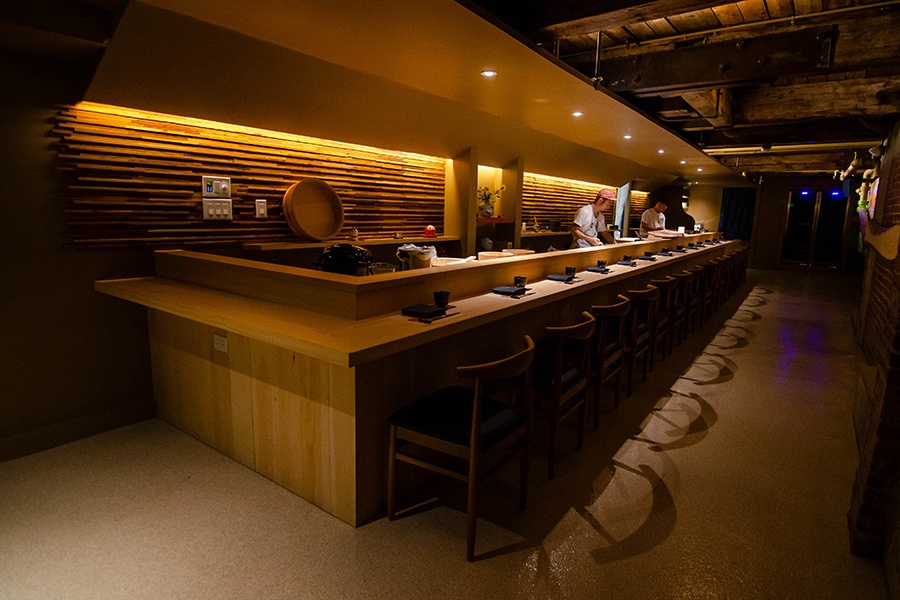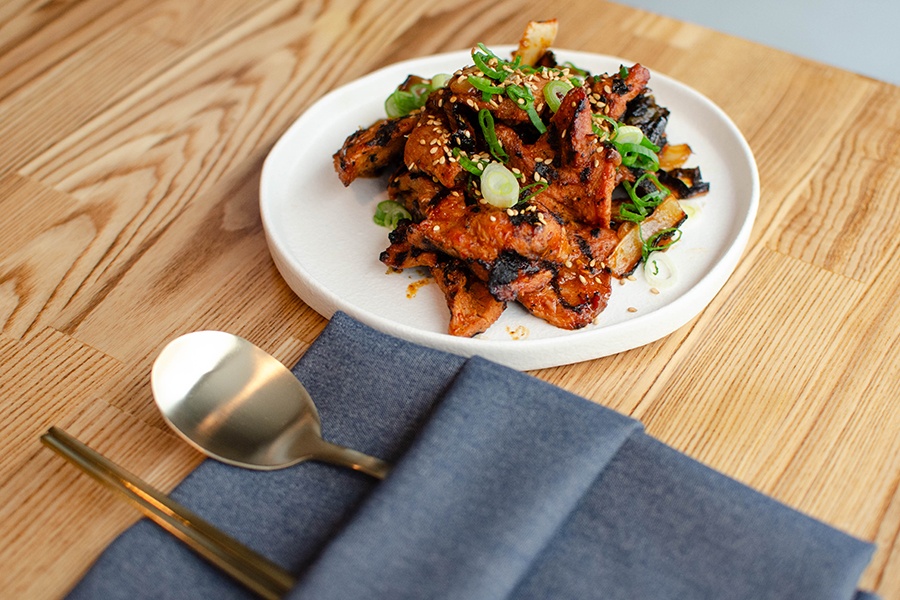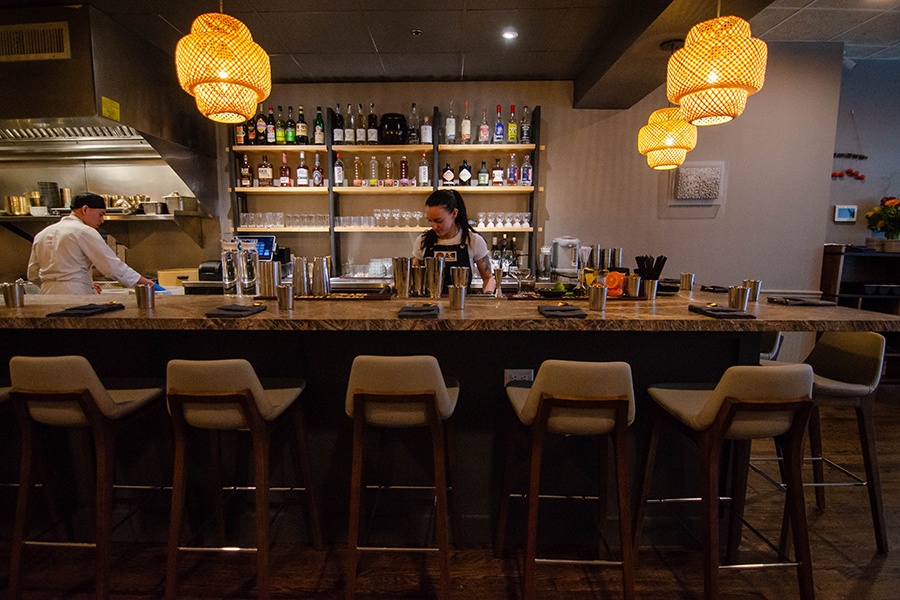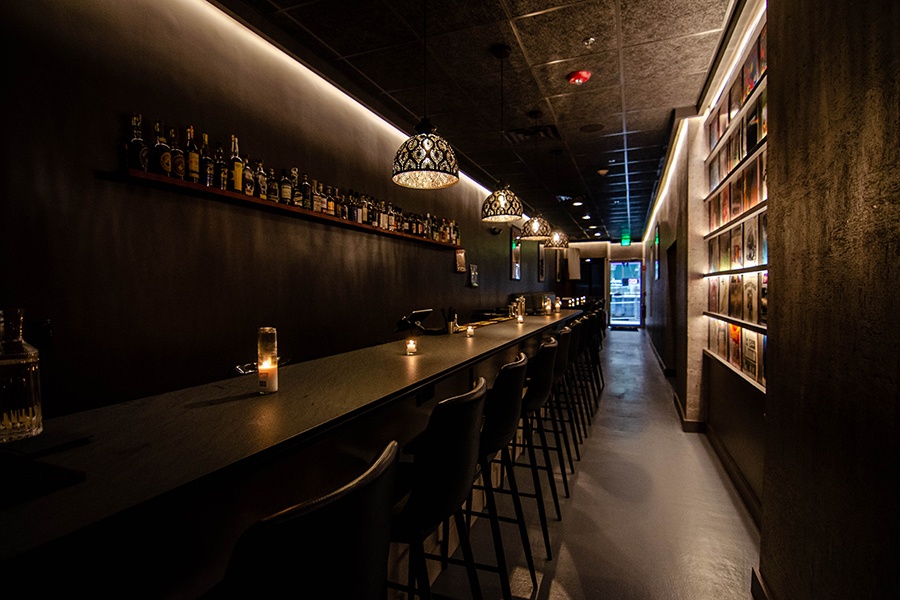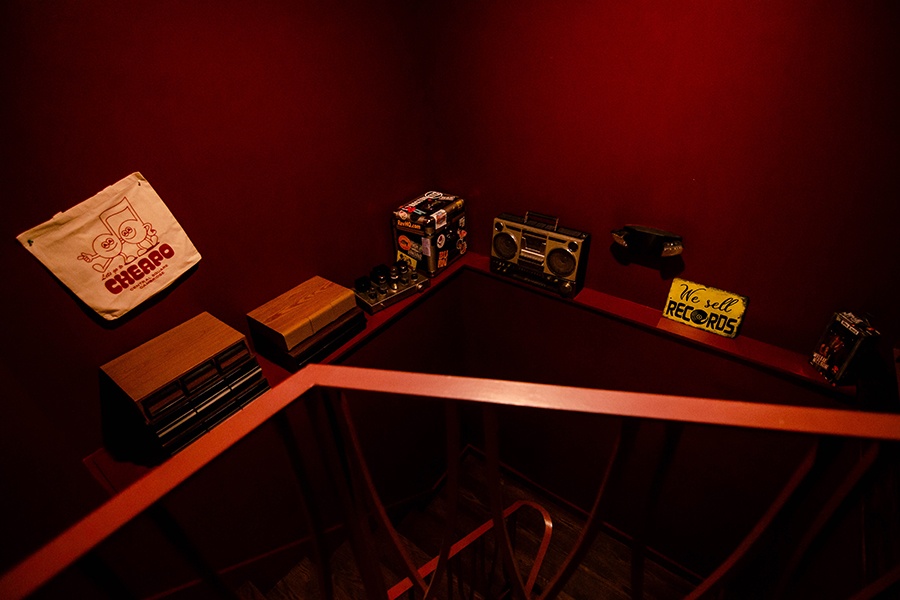Soju, Sounds, and Sushi: A Restaurant Trio Opens in Downtown Crossing
Restaurateur Jamie Bissonnette and the JM Curley crew have come together to open a Korean restaurant, vinyl listening lounge, and subterranean sushi counter.
Downtown Crossing is now home to a taste, or three, of contemporary Asian cuisine, culture, and cocktails with the debut of a trio of new food and beverage venues. Under the same ownership—but each with its own distinct personality—the spots opened in late March, paying homage to Korea and Japan in what chef and partner Jamie Bissonnette, a James Beard Award winner, describes as his “most personal” projects yet. There’s Somaek, a Korean restaurant influenced by home-cooking and family; Temple Records, a music-focused lounge inspired by Japanese listening bars; and Sushi @ Temple Records, a minimalist sushi counter. Designed as separate entities—although you’re certainly welcome to, say, follow up dinner at Somaek with a cocktail next door at Temple Records—the three inhabit the former Herrera’s address on Temple Place and a long-empty, adjacent sliver of narrow space.
The new spots are a collaboration among restaurateurs Bissonnette, Andy Cartin, and Babak Bina, the latter two co-owning another trio a few doors down the street (JM Curley, Bogie’s Place, the Wig Shop). Bissonnette previously partnered with restaurateur Ken Oringer on Boston mainstays Toro, Coppa, and more; that longtime partnership ended last year.
Bissonnette and Cartin have been friends for years, having worked together at a restaurant in West Hartford in the 1990s. “[Cartin] is one of my ride-or-dies,” says Bissonnette, who ultimately met and got “wicked tight” with Bina, too. “As things were changing in my professional career and I didn’t know what I wanted to do next, we were all sitting down one day having lunch, casually talking about a possible project they had in the works,” says Bissonnette. “They asked if I wanted to consult or be a part of it.” That project didn’t come to fruition, but the seed of a partnership was planted, and when the owner of Herrera’s approached Bina and Curtin about buying his business, they went to Bissonnette to ask what he’d want to do with the space. His answer? A Korean restaurant.
Korean cuisine was fresh on his mind: He had recently returned from his pandemic-delayed honeymoon to Korea and Japan with his wife Song. In Korea, he spent a lot of time cooking with his mother-in-law, Soon Han, whom he calls Mom. “It felt like [a Korean restaurant] is what I wanted to do,” says Bissonnette. And when the team toured the property, the landlord also showed the adjacent space and its basement, noting that they could all be combined. Inspired by the Japan segment of his honeymoon, avid vinyl collector and self-proclaimed “audio nerd” Bissonnette imagined a “little narrow record bar” like the ones he and his wife visited in Osaka, Kyoto, and Tokyo. “I loved the vibe, so I said to the boys, ‘Why don’t we try doing a listening lounge?’”
The final piece of the puzzle fell into place as the team walked down to the basement. “It reminded me of being in the Tokyo neighborhood of Ginza where a lot of the sushi spots were downstairs,” says Bissonnette. “You’d go up to a building, like, ‘What is this place?’ and then walk down winding stairs, and all of a sudden there was a sushi room with great fish.”
Don’t think of this as some sort of fusion among sushi, Korean home-cooking, and cocktails with a genre-hopping vinyl soundtrack, all under one roof. While there are some shared inspirational roots, the team’s intention is to keep Somaek and the Temple Records businesses distinct. “We don’t even commingle ingredients except for, like, onions and garlic,” says Bissonnette. “For sushi, we have Japanese soy sauce; for Somaek, we have Korean soy sauce. We don’t want it to become a hodgepodge.”
The common ground among the spaces, says Bina, is more design-oriented, an approach that’s “very minimalistic with clean lines and earth tones, utilizing colors that have been such an influence in East Asian architectural design for hundreds, if not thousands, of years,” he says. Temple Records, for example, has a dark granite bar top “that almost looks like it’s the deep ocean,” while light, natural woods abound next door in Somaek. And downstairs at Sushi @ Temple Records, the team embraced the Japanese design philosophy of wabi-sabi, appreciation for the beauty in imperfection. Granite foundation and rugged wooden beams original to the building—possibly 200 years old, estimates Bina—frame the space, while the sushi counter itself is hinoki, also known as Japanese cypress, a light wood with a subtle evergreen scent. Bina spearheaded the design and construction of the spaces alongside local firm Lisa Davis Interiors.
Here’s a closer look at the three concepts.
Somaek
The restaurant is named for a Korean drink “similar to what we would call a boilermaker,” says Bissonnette. “You take the rice-distilled spirit soju and maekju, the Korean word for beer. The ratio is arguably different for everyone, but it could be, like, 70 percent beer and 30 percent soju. You put them together, stir it up, aggravate it, let it bubble up, and you’ve got somaek.” (It’s great after golf, says Bissonnette’s mother-in-law, Soon Han, who is at the restaurant helping with the opening and is credited on the menu as Somaek’s consulting chef.)

Somaek’s kkaennip-jeon: egg-battered and stuffed sesame leaf with beef, tofu, and vinegar soy. / Photo by Rachel Leah Blumenthal
The goal of Somaek is to be true to “the Korean food that we had in Korea and that I’ve had with Mom,” says Bissonnette. “We didn’t want it to be the Instagrammable, trendy dishes like cheese dogs and ‘Korean fried this’ and ‘Korean fried that.’ We wanted it to be more like home-cooking.”
“I’m very proud of Jamie because he’s not Korean and he loves Korean food more than us,” says Han. While genres of entertainment like K-pop and K-dramas are gaining widespread recognition here, along with some of those trendy Korean dishes, more traditional takes on the cuisine are less prevalent here, she says. “Jamie goes to the mainstream to introduce our Korean food to the American people, and that’s very important,” says Han. When she saw the final menu, she was surprised at how closely it related to what she cooks at home. “I don’t think anybody is serving this kind of food [in Boston],” she says.
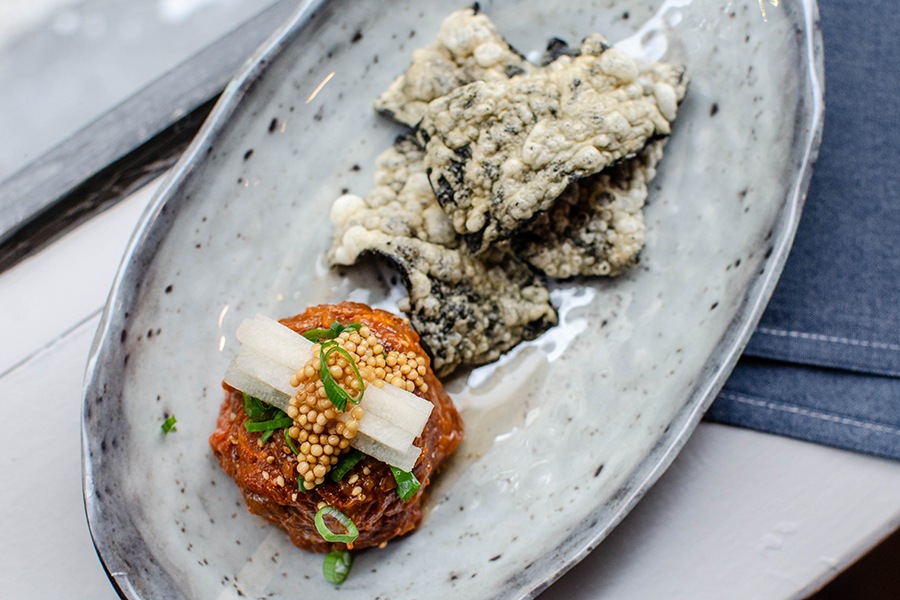
Somaek’s yukhoe: steak tartare, egg yolk, Korean pear, pickled mustard, and gim bugak. / Photo by Rachel Leah Blumenthal
Bissonnette and Han are both particularly excited to serve bibim guksu at the restaurant, a dish of cold noodles with spicy gochujang, a boiled egg, cucumber, and seaweed. It’s a dish that stood out to Bissonnette when eating Han’s food in Korea. Plus, you don’t see cold noodle dishes too often in the States, he says, “except for pasta salad.” It’s a special dish to Han, too, her favorite during college: “Hot sauce, cold noodles, in the wintertime or summertime, doesn’t matter.”

Somaek’s bibim guksu: cold noodles, gochujang, boiled egg, cucumber, and gim. / Photo by Rachel Leah Blumenthal
Naturally at a restaurant named for a drink, there are interesting beverage options (including the namesake somaek). “Andy [Cartin] really went full force into understanding all of the different Korean liquors,” says Bissonnette, “so we’re featuring a lot of things that we’re really proud of, like makgeolli, yakju, and takju. They’re made in the United States in the Korean way at a distillery in Brooklyn.” Cocktails showcase Korean flavors, too, like the Jjinppang, which complements Don Q rum and Amaro Nonino with red bean, black sesame, and lime, or the Maekjulada, with Jinro soju, Terra, gochugaru, tomato, soy, and lime.
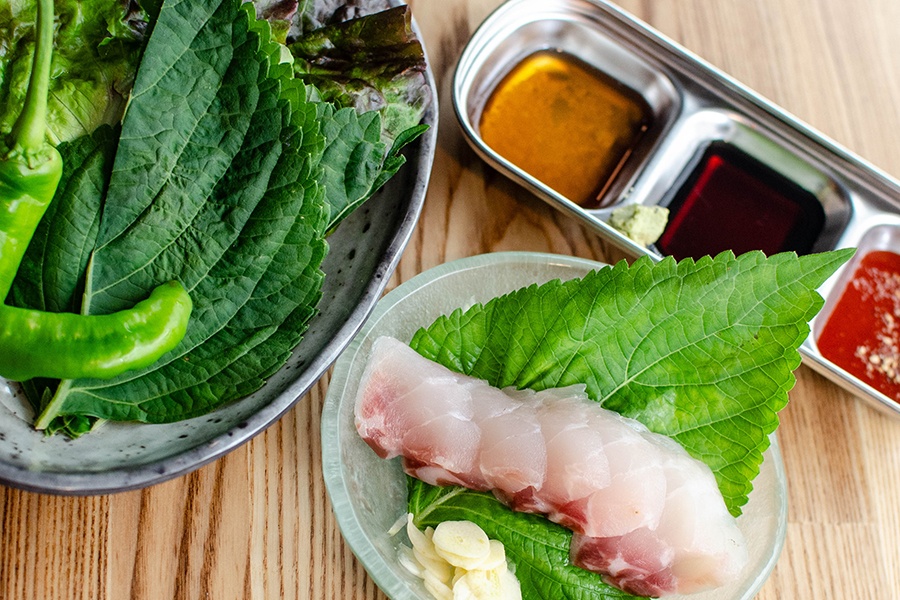
Somaek’s nong-eo hwe: Korean striped bass sashimi with sesame oil, wasabi, chojang, and ssam. / Photo by Rachel Leah Blumenthal
“A lot of people think of Korean restaurants as big beer towers and partying and late-night,” says Bissonnette. “That’s awesome, and fun, and I love doing that, but we wanted to do something chill. What we’re doing at Somaek reminds me a lot of Korea.”
The small space—16 seats, plus 13 at the bar—is decorated with Korean art gifted by Bissonnette’s in-laws and is full of utensils and plates Bissonnette, Cartin, and Bina found on a recent research trip to Korea. “You walk in and it just smells right and feels right,” says Bissonnette. “The only difference is we’re playing hip-hop or soul or R&B.”
Temple Records
Next door to Somaek, music lovers will find a long, narrow, dark bar with killer acoustics. There’s a large wall of records on display, any of which you might hear during your visit, as well as posters and knick-knacks representative of Japanese music culture.
In his travels, Bissonnette went to record bars in both Korea and Japan; in the former, he found them to be “convivial, loud, big, everybody singing along.” He loved the energy, but it’s the “more subdued, chill” version in Japan that he’s emulating here. “It’s really more about the fidelity,” he says, and sharing his extensive, eclectic record collection in a space designed to be conducive to listening. (Cartin even avoided putting shaken cocktails on the menu to keep down noise levels.)
When Bissonnette describes his music tastes as eclectic, he means it: On any given night at the bar, you might hear everything from Key Boys, a 1960s Korean rock band with Beatles vibes, to funk, soul, and blues, to the occasional punk and hardcore if it’s late at night and Bissonnette’s friends are visiting. “Generally speaking, it’s pretty chill music, though,” he says, “anything from James Brown to Dave Brubeck to Oscar Peterson.”
In the coming days, an offshoot of the downstairs sushi menu (more on that below) will become available upstairs at Temple Records—some plates of sashimi and nigiri, maybe one or two maki, says Bissonnette—but the focus at the tiny cocktail bar is really on the music.
Sushi @ Temple Records
Downstairs, the subterranean sushi bar is all about simplicity. “There’s so much great omakase and so much innovative new-style sushi out there that sometimes I long for a place like where you could go in the Osaka subway and just get a simple plate of shiso, uni, and umeboshi,” says Bissonnette. “When we interviewed [sushi chef] Kenta Katagai and brought him here from Hawaii, we told him we wanted to do something really straightforward, and that’s what he wants to do, too. It was the perfect kind of symmetry.”
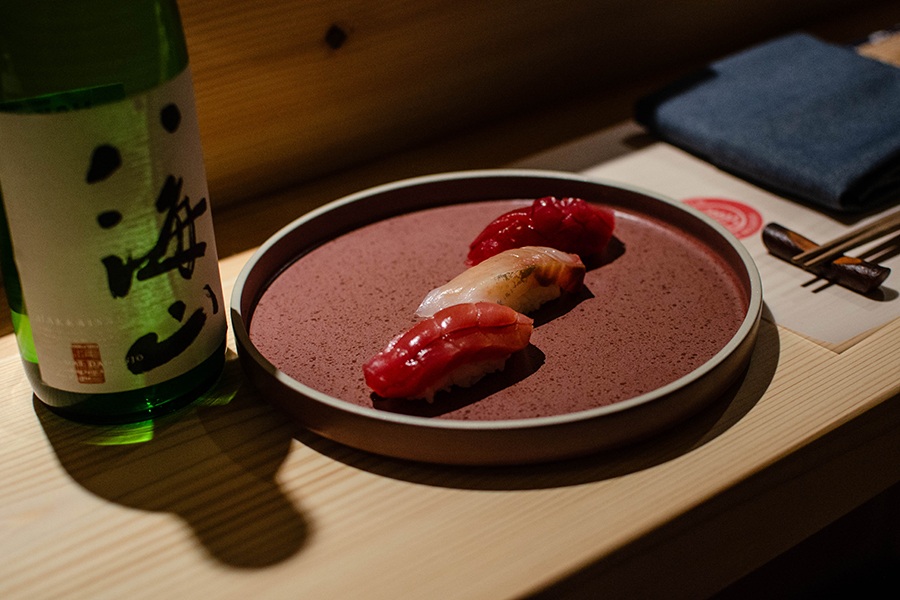
Sushi @ Temple Records’ nigiri: hon-maguro chutoro (medium fatty bluefin tuna) from Mexico, kanpachi (amberjack) from Hawaii, and hon-maguro akami (bluefin tuna) from North Carolina. / Photo by Rachel Leah Blumenthal
Much of the nigiri is just fish, rice, fresh wasabi, and soy sauce, says Bissonnette. “There are a couple things that get a salt here and there, and something might get brushed with ponzu, but generally, it’s all pretty minimalistic and traditional. We don’t want it to feel precious.”
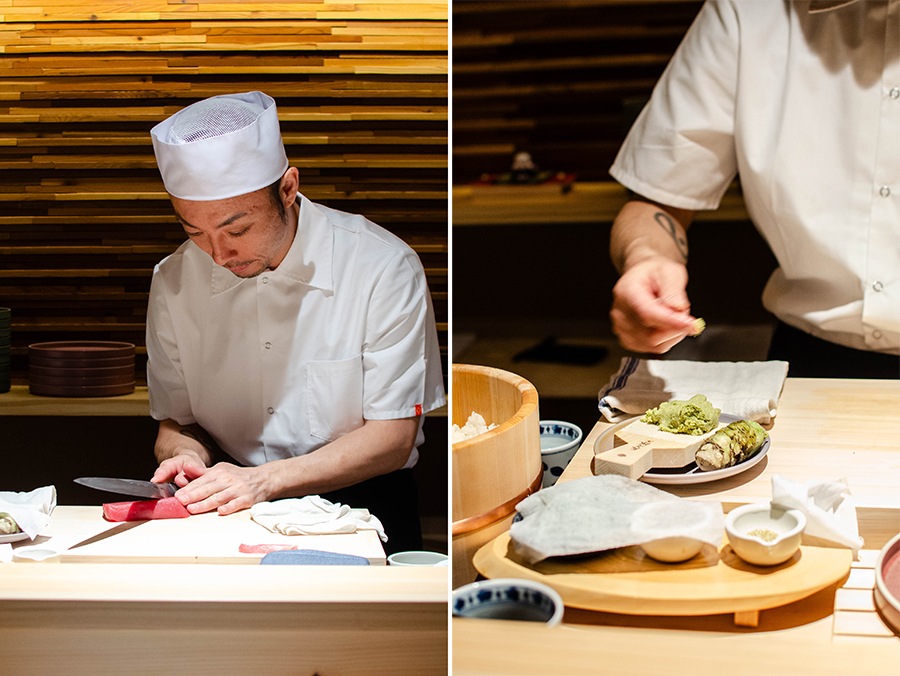
Sushi chef Kenta Katagai prepares fish and wasabi at Sushi @ Temple Records. / Photo by Rachel Leah Blumenthal
Anything else visitors to the new venues should know? “Don’t fucking steal any records if you come here, man,” says Bissonnette. “These are my personal records. A lot of them have sentimental value, and I don’t want to have to lock them up because I want to be able to look at them.” And it’s not just the records that are personal—it’s the project as a whole. “These are more personal than any restaurant I’ve ever had.”
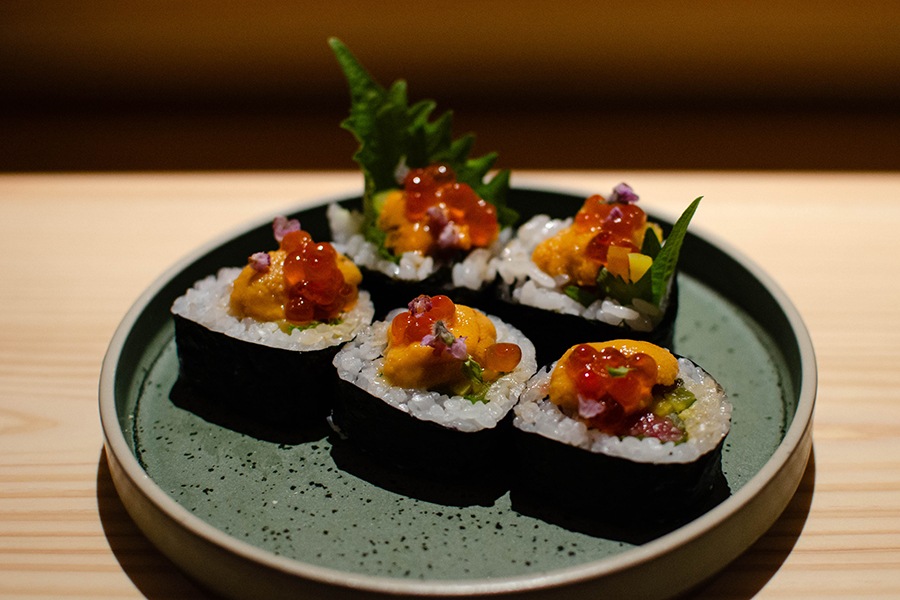
Sushi @ Temple Records’ house roll, tera maki: chutoro, uni, ikura, shiso, and takuwan. / Photo by Rachel Leah Blumenthal
11-17 Temple Pl., Downtown Crossing, Boston, somaek.com, instagram.com/templerecordsbar, instagram.com/sushiattemplerecords.
